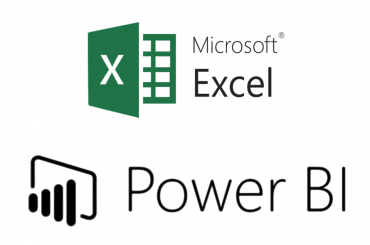Tableau and Power BI are probably the two best-known products when it comes to self-service business intelligence and visualization tools. Although there are many similarities between the two products, there are also a number of differences. Deciding which is the right product is not easy, and it’ll depend on the situation you find yourself in. In this post, we’ll analyse both products, and help you decide which might be best for your needs.
What do Tableau and Power BI do?
Tableau and Power BI are both comprehensive self-service business intelligence tools, with a focus on data visualization. This means that both tools allow you to:
- Import data from a wide variety of sources.
- Analyze it and obtain insights quickly by creating visualizations and dashboards.
- Share dashboards with other people in your company to spread insights throughout your organisation.
A key feature of both products is that little or no coding knowledge is required to create compelling charts. Instead, charts are usually created by dragging and dropping fields on the screen. This make business intelligence accessible throughout an organisation, and allows users to easily obtain insights from their data.
Both brands incorporate a range of products, including a desktop application for creating visuals and dashboards, an online service that can be used to distribute them, and a mobile app that can be used to view them on your phone.
What Are Tableau’s Strengths?
More Experienced
Tableau has been around since 2003, and for many years they have been the market leader when it comes to visualization software for many years. As a result of this longevity, the Tableau product is probably more developed and refined than Power BI.
For instance, the range and quality of visualizations offered by Tableau currently is ahead of what Power BI offers, although this gap is reducing all the time. Similarly, the user interface of Tableau is tends to be slightly easier to work with for most people.
Better Compatibility
Tableau also has the advantage of being fully compatible with Windows or Mac operating systems. With Power BI, only the online service is available on Macs.
Tableau also works better with very large data sets. For example, charts in Power BI are limited to 3,500 data points. If your charts have more data than this, then Tableau is a better option
Robust Security
From an organisational point of view, a major advantage of Tableau is that it can be deployed through the cloud or through an on-premise server. This can be a big issue for large companies, which may have strict controls on uploading data to the cloud. For these companies, Tableau is likely to be an optimal solution. While Power BI does provide an on-premise solution called Power BI Report Server, but the functions it offers are limited in comparison with their online service.
What Are Power BI’s Strengths?
Strong core functionality
While Tableau may be the market leader, Power BI is gaining ground on it. All the core functionality of Tableau is also available in Power BI, and Power BI is already good enough to be used in most situations that Tableau can be used for.
Ease of integration with Microsoft ecosystem
Power BI is a Microsoft product, and many businesses around the world run on Microsoft products. If your business uses Office 365 or the Azure cloud, then you will be able to get the most out of Power BI. To an extent, you also save your company from the difficulty of adopting a new, different tool.
As a Microsoft product, Power BI also benefits from rapid development, with updates and new features being added every month. As a result, there is a strong possibility that Tableau’s current advantages will be closed in the coming years by Power BI.
Cost-effective
The other major advantage of Power BI is its cost. Power BI Desktop, the tool used for authoring reports, is entirely free, regardless of how you use it. The online service has a Free version and a Pro version. The Pro version is needed to share content with other people, and the Free version is intended for personal use. However, the Pro version is reasonably priced, at just $10 per user per month. This compares very favorably with the cost of comparable Tableau products, and makes Power BI a great option for smaller or budget conscious companies.
Should you pick Tableau or Power BI?
There is no absolute answer as to which product you should pick. Both products have significant custom for a reason. The appropriate product for your needs will depend on the situation in your company.
Both products are designed to be accessible to those without large technology expertise. However, if the users are more experienced with technology, Tableau may be preferable, as these users may be able to exploit the more advanced capabilities of Tableau that are not yet replicated in Power BI. Otherwise, Power BI may be more appropriate. For these users, the relative familiarity of the product, due to the Microsoft feel to it, may make adoption easier.
If you are in any way cost conscious, Power BI is likely to be the best option. For most users, particularly in small companies, the differences in cost will outweigh the differences in functionality. If your business is built on the Microsoft stack, then Power BI will be much easier to integrate into the rest of your business.
Larger companies are more likely to use Tableau. For these companies, business intelligence can be seen as more of an investment, and the costs of Tableau are less likely to be a deterrent. These companies may value the ability to keep everything on their own servers on-premises. For smaller companies, the lower price point of Power BI will probably prove attractive, and uploading data to the cloud will not prove much of an issue.
If you are unsure, don’t hesitate to download Power BI and start of working with it. You have nothing to lose if it doesn’t work for you. Tableau offers a free trial that you can also experiment with, but obviously this is time limited. In both cases, you can also run a free trial of Kubicle’s training to get to grips with the functionality.
Conclusion
Tableau and Power BI are the market leaders in the area of self-service BI and visualization software, and they’re likely to remain the two front runners for the foreseeable future. The appropriate tool for your needs is dependent on the situation you find yourself in, but in reality both tools have very similar levels of functionality, and for most people either of them is a perfectly valid choice.








